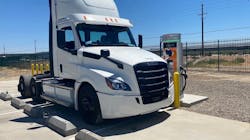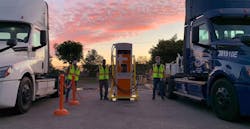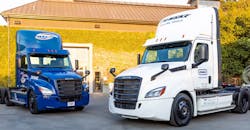DTNA continues to build electric truck momentum
Daimler Trucks North America (DTNA) is back to building commercial trucks at the same rate it was before the COVID-19 pandemic hit the U.S. in March, explained Roger Nielsen, DTNA president and CEO, during an Aug. 17 virtual roundtable with industry media. And, while reiterating his 2019 sentiment that “the future is electric,” Nielsen said DTNA is well on its way to putting battery-electric vehicles on the road in every segment it operates.
“We went through quite a tough period on the sales side and production side,” Nielsen said. “At one moment in April we had nearly 15,000 people furloughed out of 23,000. It was quite an impact for us.”
“Every one of our customers has come out of this pandemic really strong,” Nielsen added. “Today, we are back to building vehicles at the same rate we were before the pandemic hit America. We are glad to be back up and running.”
Nielsen said the pandemic will lower the total production volume for the year, but July was a relatively good month for retail sales—up 7,000 units for Class 6 through 8 in North America. DTNA expects to sell around 310,000 vehicles by the end of the year, compared to last year’s number of 492,000.“It’s definitely not going to be 2019, but it’s still strong,” Nielsen explained. “A lot of it is replacement demand; 2015 was a strong year, so those trucks, four years later, started coming back to us for replacement and continue now for 2020.”
DTNA has already begun taking orders for 2021, he said.
Emphasizing what a tough year 2020 has been, Nielsen added that the pandemic was complicated by social impacts and nationwide outcries around the death of George Floyd, an unarmed Black man killed at the hands of police in Minneapolis. Much of that civil unrest lately has been centered in Portland, Ore., where DTNA is headquartered, Neilsen added. However, he explained that the protests and riots have not impacted DTNA’s ability to produce and test trucks.
“It has affected our social conscious,” Nielsen said. “We are not going to stand silently and watch this happen. We feel as a major corporation in North America, we have a voice, and a strong voice, with operations in nearly every major city, between us and our dealers. We have the ability to put our voice and our power behind that.”
As part of the company’s external communications program against social injustice, DTNA intends to focus its efforts on supporting minority-owned dealerships and fleets.
Electric future
At ACT Expo in April 2019, Nielsen declared that the future is changing, and that “the future is electric.” During the call with industry media, Nielsen emphasized DTNA’s intent to put new products on the road, release new innovations, and develop new partnerships to continue to grow and innovate the business.
“As I said back in 2019, the future is electric, and we are now well into our business of putting battery-electric vehicles on the road in every one of the segments that we compete,” Nielsen said. “The changes we have talked about seem to be accelerating from CARB [the California Air Resources Board] to the MOU among the 15 states that are interested in what CARB is doing. We have been on this road to electrification for some time.”
DTNA recently surpassed 300,000 cumulative miles of use on the Freightliner Innovation Fleet of eM2s and eCascadias. As a followup to that real-world testing, the truck manufacturer is in the midst of deploying the Freightliner Customer Experience Fleet, which will add a number of new customers to commercial battery-electric vehicle operations. DTNA is also close to delivering the first of its electric school buses.
So far, DTNA has delivered 30 trucks in its Innovation Fleet, which consists of 10 medium-duty eM2s and 20 heavy-duty eCascadias testing in a variety of applications, including drayage, regional and local delivery, food distribution, and parcel delivery. DTNA has partnered with NFI and Penske Truck Leasing to learn the ins and outs of how the vehicles operate, how the infrastructure is put together, what it costs to maintain the trucks, and what changes need to be made for the vehicles to operate at the highest efficiency.
DTNA has been helping customers navigate the e-mobility ecosystem through its e-consulting group, explained Nielsen. Consultants are helping fleets navigate electric-truck incentives and how to apply for them, how to get the right infrastructure in place, and how to get the right permits in place, he added.
“There is a lack of knowledge out there, so we’ve stepped up and are requiring a lot of the technical resources to execute on this idea that they can convert some of their fleet to battery-electric vehicles,” Nielsen explained.
Nielsen added that working with customers has “put us that many steps ahead in our development that we otherwise would have suffered through had we tried to test these vehicles on our own.”
In addition, DTNA has been working with ChargePoint, an electric vehicle charging provider, to install both customer and depot charging infrastructure.
“We believe that depot charging, as we get started, is going to be the way we need to find energy for our vehicles,” explained Nielsen, adding that DTNA is testing depot charging because of the slow rate of public charging infrastructure development for commercial vehicles.
Regarding whether battery-electric trucks will be ready by the end of 2021 as initially projected, Nielsen said, “they’re ready.”
“We are hauling freight today, but our next version will come out in early 2022 with the eCascadia,” he said. “There is still a lot of testing between now and then, but the timing is about where we were.”
About the Author

Cristina Commendatore
Cristina Commendatore is a past FleetOwner editor-in-chief. She wrote for the publication from 2015 to 2023.


